There are spoilers.
Director: Brad Bird
Screenplay: Tim McCanlies
Story by: Ted Hughes
Starring the voices of: Jennifer Aniston, Harry Connick, Jr., Vin Diesel, James Gammon, John Mahoney, Eli Marienthal, Christopher McDonald, and M. Emmet Walsh.
Images from the 2004 WHV release.
There are few films that are for children (and maybe adults) that I actually like. Fewer still that can be universally appealing while still rising above the level of entertainment with something valuable to say. The Iron Giant, I think, accomplishes this with gusto, and has a strong flare for visual storytelling while having dialogue that enhances its overall aesthetic. Even though it's animated, I feel the film hearkens to an inner truth better than many live action films, and in doing so, achieves a kind of poetic realism. The movie is not only an exhilarating experience, but also serves as a contemplation on youth, imagination, violence, and trust.
The film is often compared with E.T.: The Extraterrestrial, and while I've enjoyed E.T., I'd rather sit down with The Iron Giant. Perhaps it's the pining sense of nostalgia throughout the film that gives it an aesthetic. For me, E.T. feels a bit dated and like a product of its time whereas The Iron Giant feels like it will be more timeless and universal. The film takes place in the middle of the Cold War, when national paranoia reached its zenith and the threat of nuclear war lurked in everyone's minds.
The movie is about a young boy named Hogarth Hughes living with his mother, Annie who befriends the eponymous iron giant. Hogarth is like any other boy you find in a family movie, with a sense of adventure and inventive discovery that people seem to lose as they age. It's interesting that the film is set in the 1950s, and because of that, it becomes a nostalgic retrospective.
Perhaps it's just me, but I feel that nowadays, we are growing up faster than ever. It's as if children can't wait to grow up, start driving, and move out of their hometown. Yet, I feel as if our minds were by far at their peak dynamism when we were children. I remember when a simple couch was more than just something to sit on. It could become a space ship, a sail boat, or whatever I wished. Now (and I feel like an old codger for saying this), I look at a couch, and I see... a couch. Part of me wishes I could recapture that imagination because let's face it, I have the rest of my life to look at couches.
It's through this nostalgia that The Iron Giant looks back at the 1950s, and hearkens back to diners where everything seemed so much more communal.
What strikes me about The Iron Giant is how economical it is, both in telling a story as well as exploring its ideas. Almost within the first ten minutes, we already know our principal characters and we learn that Hogarth is an only child and that his mother is raising him alone (chiefly through a telephone call where Annie tells Hogarth she will be working late and that he isn't allowed to stay up). That nothing is stated explicitly about the absence of a father (or siblings) proves just how eloquent the film is at telling its story cinematically, not literally or verbally. The competence of the storytelling is deceptively simple, and I've seen many movies that fail in this regard.
Not to mention it has genuinely funny moments that are neither Family Circus cutesy nor in need of resorting to vulgarisms. Like when Hogarth's "pet" squirrel has crawled up Dean's leg and mayhem quickly ensues throughout the diner. The shot of Dean's expression when meeting Annie while trying not to wig out is priceless, and the delivery by the actors hilarious.
The economics of The Iron Giant allow for scenes that do a lot of work in addition to drawing parallels between other scenes. For instance, Annie tells Hogarth he cannot watch scary movies and must be in bed by 8 o'clock. An instant later, we see him stuffing Twinkie's with whipped cream and watching a campy movie involving a killer brain. This helps to establish Hogarth like any other boy, and he becomes more relatable because let's face it, how many times did you stay up late watching movies when your parents told you not to?
The kicker to this scene is that it forms a dichotomy with Hogarth's own experience with a supernatural life form. We see that just like the man in the movie, Hogarth enters the dark to uncertain danger. The difference, however, is that whereas the killer brain is a fleshed out embodiment of heartless intelligence, the iron giant is an intelligent, metallic being with a heart.
I suppose an argument could be made that the scenes work to contrast television vs. imagination (ah, the age old battle!) and suggest that television works to dehumanize and desensitize us, whereas imagination allows us to cultivate a more dynamic perspective and a deeper respect for life, as well as reject our prejudices and our expectations.
It seems like we could solve a lot of world problems and absolve a lot of differences if people had the innocence and imagination of a child. The movie clearly expresses this notion, and it is Hogarth that recognizes there is a person within the metal exterior of the giant. An adult would look at the electrocuted giant and "rationally" stay away from potential dangers.
I've said it before, but for a movie to express certain ideas well, contrast is best. The Iron Giant tells us visually that the ability to believe in the fantastical lies mostly in children, whereas adults have their backs to these notions of the supernatural:
The backlighting here is not simply the usual device to divide "good" and "evil" because I don't feel anyone in the film is evil incarnate. A few corrupt souls, perhaps, but they are satirized more than the simplistic standpoint most children's movies usually take, which is to have "good" guys and "bad" guys.
Speaking of satire, one thing the film does very well is to subvert the prejudices established during the Cold War (and prejudice in general). The film is set in the ideal atmosphere for its insinuations, and I don't believe there is a single non-white person in the film (except the giant).
Just as Dr. Strangelove pinpointed the potential for nuclear holocaust at the hands of a bunch of middle-aged men, The Iron Giant examines these prejudices through a satirical eye. The scene in Hogarth's classroom consists of what's essentially a propaganda film, with the asinine idea of "duck-and-cover." There is a hilarious shot where a cartoon atomic bomb blows up the school and the girl who has hid under her desk is safe within a crater of destruction all around. Yeah, those must've been some solid desks.
What makes this scene really work is the conversation amongst the boys, who clearly carry a prejudice of "foreigners," saying the giant was probably a weapon from another country. The word "foreign" in the film carries with it a negative connotation, and I feel their parents and their schools are the ones responsible for teaching this attitude. In that sense, Hogarth becomes emblematic of tolerance and understanding, and maybe it means something that he doesn't have a father in the movie.
One of the conscious decisions by the director, Brad Bird, was to film in a Cinemascope format. The extra widescreen offers interesting compositions of the giant, who is only shown in parts, or at a great distance. Perhaps my favorite shots are the ones where we see the giant from afar because they put him in the context of his environment. Like the very first screenshot I showed, the giant looks ironically natural as he revels in the beauty of fall colors.
A scene I like a lot is where Hogarth is rambling about his discovery of the giant, because it shows a wisdom beyond his years.
One of the lines I dig is where he says:
"This is the greatest discovery since... television or something!"
because in one sense, it shows his naivete and this gives him a kind of innocence. However, the movie shows these characters being much more complex than those in many other children's movies, because Hogarth immediately understands that "people aren't ready for [the giant]." In spite of his age, he anticipates the violent gut reaction from adults. In this sense, children have a wisdom that cannot be defined conventionally by the number of years they have. Or rather, it's more of an intuitive wisdom as opposed to a wisdom that comes from experience.
In looking at the giant, it becomes clear that the movie consistently poses the question of what a person is and comes to the conclusion that a person is defined by their inner self. Perhaps this is a cliche message, but does that dilute its importance? If anything, I think this idea is more relevant today than ever. The evolution of the relationship between Hogarth and the giant is interesting. In the beginning, it's almost like that between a boy and his dog:
"You stay, I go. No following."
And as the movie progresses, their relationship grows in complexity. I like to think that their friendship transcends the boundaries of human-dog or human-human interaction and becomes an amalgam of the very best aspects of each.
One of the more explicit morals of the film is that: "You are who you choose to be." I think the scene where Hogarth shows the giant his comic books is integral in this respect. Comic books, while the adults may scoff, contain many of the morals of more canonical fables, yet their appeal to kids can allow their messages to resonate more strongly. Hogarth likens the giant to Superman and eschews the giant's gravitation toward Atomo: The Metal Menace because he sees past the superficial similarities and sees good in the giant.
It's interesting to see how relatable and likable the giant is, and I think his simplistic features have something to do with it. The emphasis on the eyes and face is important, but also his behavior helps flesh out his humanity, like when he is trying to fit the railroad tracks together just perfect as train is barreling toward them:
One of the neatest (and most meaningful) things the giant can do is fix himself.
Perhaps the main reason this image is so powerful is what it represents in the context of the giant's function and his desire for peace (taught to him by Hogarth). From a technical standpoint, that function is to be a retaliatory weapon that is triggered when the giant is attacked:
Note how impersonal he becomes. Throughout cartoon history (I think), animators have realized that obscuring the face automatically depersonalizes the subject. What the giant comes to represent on one level is the idea that violence begets violence. Herein lies one interpretation of the giant's ability to regenerate. That is, violence is cyclic.
Another way of looking at his regenerative abilities is that he is emblematic of the desire for peace and that the giant is allegorical of the cycles of war and peace throughout humanity. There is a saying (and I don't know who said it first, but I learned about it from The Simpsons) that:
"To make peace, we must prepare for war."
In an ideal world, war would not exist. But I do not believe every war (with some reservations) is unjustified, or at least avoidable. In this respect, even those that strive for peace must be willing to accept war as a utilitarian means of achieving peace in the long run. The giant completely embodies this ideal, in part because of what he learns from Hogarth. Like humanity, the giant does resort to violence, even if it's against his better judgment.
What war does most unfortunately is foster the idea of "shoot first, ask questions later."
When one side shoots, the other shoots back and nothing new is learned. The difficulty is to break this cycle, and it is something that needs a conscious effort from both parties.
As I've said before, The Iron Giant has a satirical brilliance to it, perhaps best expressed through Kent Mansley, a government agent sent to investigate the giant. Christopher McDonald's voice is really perfect for Mansley because it has a heavy sense of sarcasm and sleaze ball character that McDonald is known for playing. It cracks me up every time I see him mocking Hogarth's name:
He becomes the brunt of much of the movie's attacks on the bigoted untrusting government official, and it's apparent that the film labels people like him as the catalyst and harbinger of violence (even it he's not the one doing the shooting). For instance, we see him in the dark room developing photographs of Hogarth and the giant. Later in the film, this atmosphere is echoed through the Nautilus nuclear submarine, which launches the nuclear missile (ordered by Mansley, of course).
Mansley's name alone should be a dead giveaway. The movie does seem to take a few pages out of Dr. Strangelove's book, and the idea that violence inevitably has masculine origins is a well explored, but nevertheless fascinating theme for study. I don't believe the movie is as cynical as Strangelove, but carries with it a small glimmer of hope.
The hope is a trust in humanity, and the idea of trust is one of the paramount messages of the film. The trust between the giant and Hogarth stems from intuition more so than experience, and if you think about it, it does fly in the face of "rationality." The trust he and Hogarth have is perhaps tested to its limit when he unintentionally attacks Hogarth after bring triggered by a toy gun.
It's at this moment that Dean's adult rationalities reject the giant. It's like finding out your dog has rabies (Old Yeller, anyone?) and you no longer want anything to do with him. The giant is, after all, a metallic creature which would seem to automatically dehumanize him. And yet, he expresses an incredible sense of emotion as well as empathy for other living beings. He feels real sorrow at the death of a deer, perhaps because it was a senseless death. And he feels real sadness and anger over the harm that has come to his friend.
Perhaps the most trust-affirming image is when Hogarth believes in the humanity of the giant at his most violent state.
It is this act that completes the belief that those who commit the actual violence are still human and can still choose to throw aside their weapons. Even the general seems to be humbled by the end, and I don't think he's a morally reprehensible person. Perhaps he has misguided prejudices, but that is more of an inheritance of the system he lives and works in than of his own construct. It seems that the person most responsible for the violence is the one that, more often than not, is the one most removed from it. This notion was thoroughly explored in Paths of Glory, and in The Iron Giant, Mansley becomes the Iago-like character.
Ultimately, the film affirms the idea of choice. That is, even if we are born with prejudices and were raised on them by the society we grew up in, we have the choice to reject them.
The Iron Giant is an exceptional film, in part because it is told with uncommon intelligence and also because I would show it to anyone. The film, I think, has garnered a strong fan base, and I suspect it will become one of the most enduring animated films in years to come.
I think the ultimate message of the film is that life is a learning process, and from the ruins of our mistakes, we must rebuild ourselves and try yet again. Perhaps it is inevitable that violence will ensue, but by learning from what went wrong, we can strive for peace, and maybe someday we will reach it.
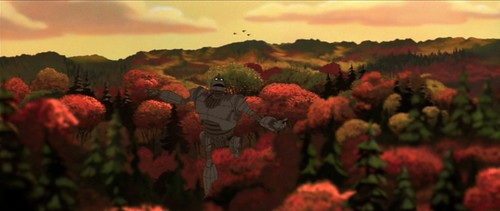
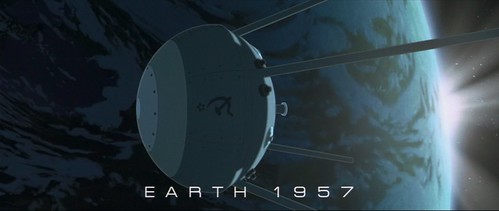
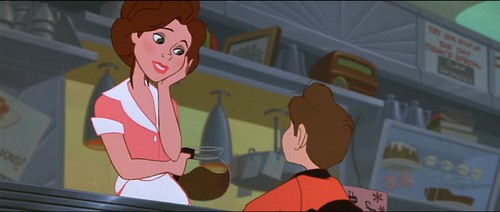
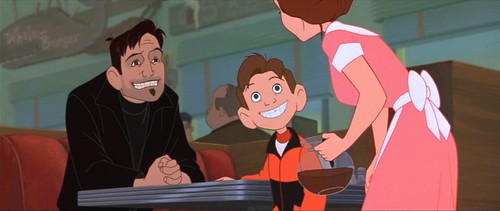
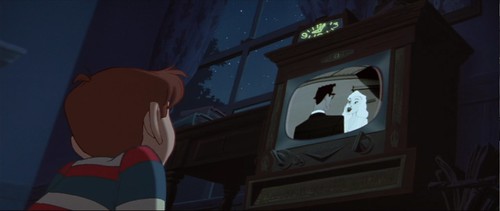
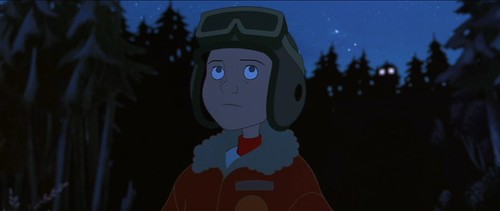
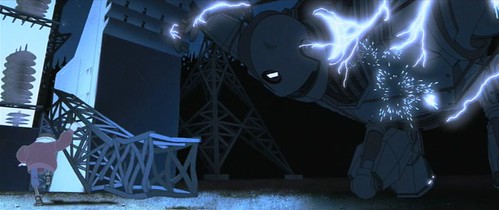
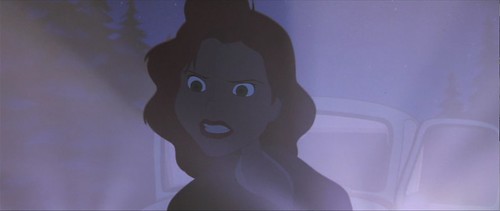

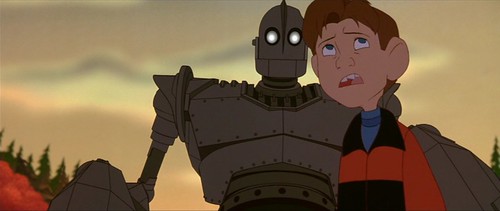
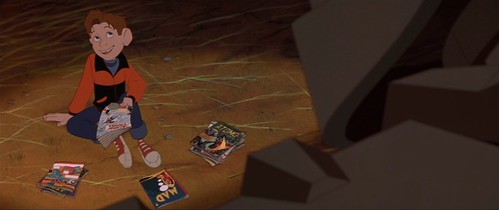
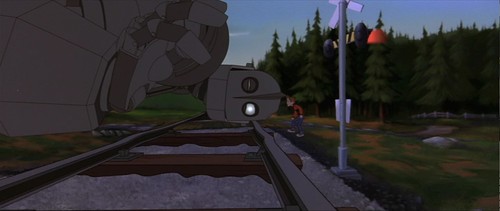

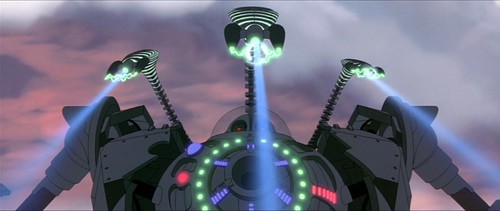
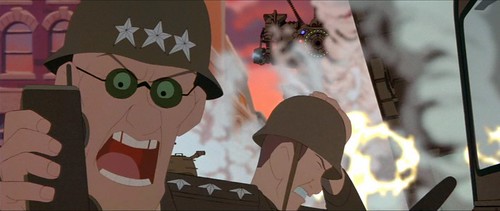
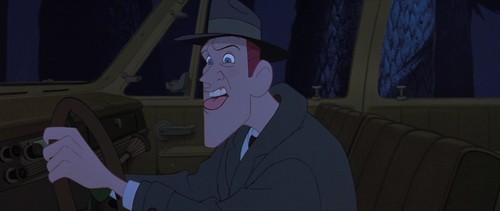
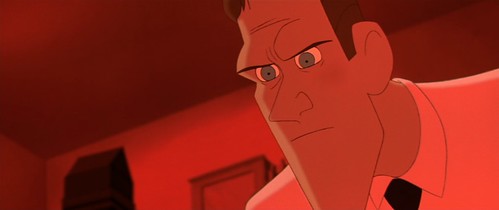
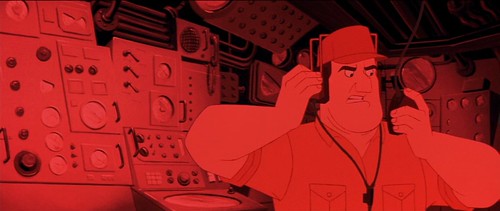
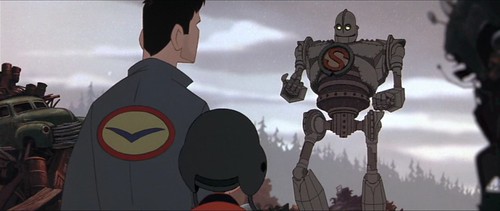
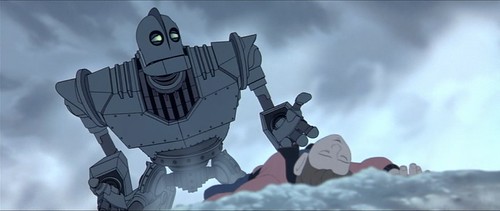
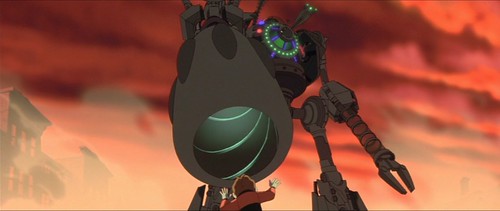
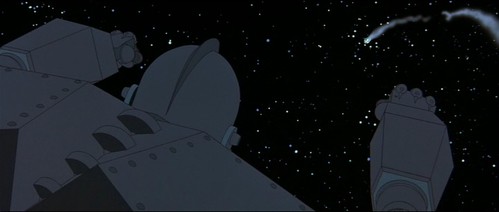

This is fantastic. I'm currently doing a project on The Iron Giant, as I'm in a class about immigration and the fear of foreigners through alien/monster movies.
ReplyDeleteThis is fantastic. You have the exact feelings I put into my paper and presentation. This movie is so great on so many levels, and I agree that it is an ageless film.
Awesome analysis.
I love this movie. Ive seen this movie about a million times and it seemed perfect for my project. I have to write about a movie that takes place durring the Cold War and how the movie fits that time period.
ReplyDelete